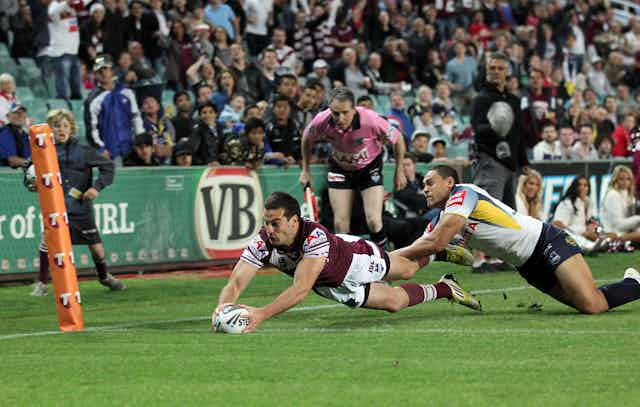Referees in need of coaching for “emotional intelligence”? Controversy over crucial line decisions in major matches? Criticism raining from the heavens? That’s right: it’s finals time in Australian sport.
In addition to celebrating the virtuosity of players and the wisdom of winning coaches, it’s a time when conversations about referee and umpire behaviour inevitably come to a crescendo.
The referees at the Manly vs North Queensland rugby league game on Friday night came under intense scrutiny and comment following two controversial decisions (see video below).
And there was considerable interest in video umpire decisions at the Collingwood vs West Coast game on Saturday evening too (see video at the bottom of the article).
Both football codes exhibit the challenges faced by sports that have visually rich broadcasts. At present this coverage is fuelling folk devil and moral panic discussions about officiating.
In an age of high-quality television images it is interesting to reflect on the mediation of our experiences of football games.
Historically, most broadcasts of sport had a dominant shot. In football games this was often from an elevated position above the half way line or centre.
Today there are multiple angles that use powerful lenses and high-speed filming for remarkable slow-motion images.
Referees and umpires have to balance this broadcast infrastructure with their ability to make rapid decisions. I was so impressed by the willingness of referees and umpires to put themselves in these positions that I started to work 20 years ago with referee development officers in a number of codes.
At that time my feeling was one that remains to this day: if games require officiating then the support to officials should be as at least as comprehensive as the support offered to elite athletes and coaches.
Australia had led the world in its innovative support for officials and the professional development programs that are part of this support. NRL and AFL have been at the forefront of this movement. Both have exceptional after action review procedures in place.
I see the announcement of a rugby league academy for referees – working with the Australian Sports Commission – as an example of meeting this need at a time of increasing scrutiny of officials.
To a person, all the officials I’ve met over 20 years have impressed me immensely with their desire to improve their performance. Many of our conversations in that time have been about the application and interpretation of the rules of the game.
Playing “advantage” – allowing the game to continue if the recipient of a penalty or free kick already has an advantage – is a great example of how referees and umpires negotiate the flow of a game.
Much of the criticism of officials focuses on their “feel” for a game - their so-called emotional intelligence.
Many of the officials I have met aim to be invisible in games so that their contribution is to the experience of a flowing game that rewards skill and tactical accomplishment. At the same time they are attempting to deal with players who seek to exploit the rules.
The Manly vs North Queensland and Collingwood vs West Coast manifestations of the officiating crisis should raise questions about how we support referees and umpires.
High-profile performance has a powerful connection with the recruitment of young officials and their retention.
At all levels of sport, officiating decisions are contested by players and spectators. The availability of slow-motion images for video review is fuelling heated discussion about “critical” decisions in televised sport.
I think this is an unfair contest and has transformed our perception of sport. I applaud any attempt to support officiating performance but lament that it is perceived as “their” problem.
I see it as “our” problem in how we construe a sport contest.
Back in the 19th century when the first referees and umpires appeared in the folk football games that were the precursors of rugby league and Australian rules their main role was to prevent participants from leaving the games to go poaching!
They were in fact game-keepers.
Demands and expectations have risen exponentially since, in ways that would strain even the most intelligent of emotions.

